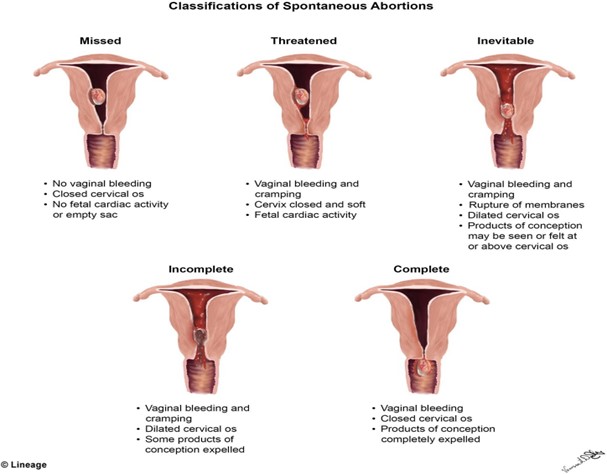A woman presents to the emergency department complaining of bleeding and cramping. The initial history is significant for a last menstrual period 6 weeks ago. On sterile speculum examination, the care provider finds that the cervix is closed. The anticipated plan of care for this woman would be based on a probable diagnosis of which type of spontaneous abortion?
Threatened
Inevitable
Missed
Incomplete
The Correct Answer is A
Based on the provided information, the probable diagnosis for the spontaneous abortion in this woman would be a threatened abortion, since the cervix is closed and there is no evidence of expulsion of fetal or placental tissue. A threatened abortion is defined as vaginal bleeding occurring before the 20th week of gestation, with a closed cervical os, and no expulsion of fetal or placental tissue.
The other types of spontaneous abortion are defined as follows:
B. Inevitable abortion: vaginal bleeding and cramping with an open cervical os, with or without expulsion of fetal or placental tissue
C. Missed abortion: fetal demise without expulsion of fetal tissue, and may be associated with a closed cervical os and absence of uterine contractions
D. Incomplete abortion: partial expulsion of fetal or placental tissue, with or without vaginal bleeding, and may be associated with an open cervical os and uterine contractions

Nursing Test Bank
Naxlex Comprehensive Predictor Exams
Related Questions
Correct Answer is C
Explanation
In the case of a bioterrorism attack involving anthrax, the main priority for the nurse is to administer antibiotics within 48 hours of exposure using the Strategic National Stockpile. Anthrax is a serious bacterial infection that can be used as a bioterrorism weapon. Antibiotics, such as ciprofloxacin, doxycycline, and penicillin, can be used to prevent anthrax from developing in people who have been exposed.
There is currently no vaccine available for anthrax exposure. Also, symptom support alone is not enough in cases of anthrax exposure, as anthrax can progress rapidly and lead to serious complications. Placing everyone who was exposed in quarantine may not be necessary in all situations, and should be determined on a case-by-case basis depending on the extent and severity of the exposure.
Correct Answer is A
Explanation
The nurse's first action should be to massage the woman's fundus. A completely saturated perineal pad within 15 minutes after giving birth indicates excessive bleeding, which is also known as postpartum hemorrhage (PPH). Massaging the uterus (fundus) can help it to contract, reduce bleeding, and prevent further blood loss. Once the fundus has been massaged, the nurse should assess the woman's vital signs and continue to monitor her for signs of continued bleeding. If bleeding persists despite massage, the nurse should begin an intravenous (IV) infusion of Ringer's lactate solution and call the woman's primary healthcare provider.
Whether you are a student looking to ace your exams or a practicing nurse seeking to enhance your expertise , our nursing education contents will empower you with the confidence and competence to make a difference in the lives of patients and become a respected leader in the healthcare field.
Visit Naxlex, invest in your future and unlock endless possibilities with our unparalleled nursing education contents today
Report Wrong Answer on the Current Question
Do you disagree with the answer? If yes, what is your expected answer? Explain.
Kindly be descriptive with the issue you are facing.
